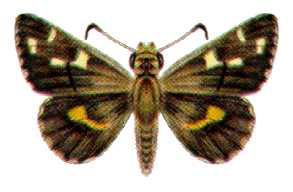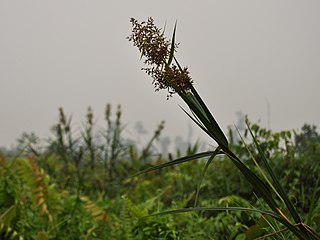Juniperus indica, the black juniper, is a juniper native to high-altitude climates in the Himalaya, occurring in Pakistan, India, Nepal, Bhutan and China.
Scleria afroreflexa is a species of flowering plant in the family Cyperaceae. It is endemic to Cameroon. It grows on mountain grasslands, including areas of grassland in forested regions. It is threatened by the deliberate burning of the grassland habitat. This plant was first collected in 1999.

Hesperilla crypsigramma, the small dingy skipper or wide-brand sedge-skipper, is a butterfly of the family Hesperiidae. It is found in Australia in New South Wales, Northern Territory and Queensland.

Scleria terrestris is a species of flowering plant in the family Cyperaceae, the sedges. It is native to much of Asia and Australia, where it is widespread and occasional. It is a rhizomatous perennial herb that grows in wet habitat, such as streambanks and wet mountain understory, and some types of dry and disturbed habitat.

Scleria sumatrensis, commonly known as nutrush and Sumatran scleria, is a plant species in the sedge family. It is native to temperate and tropical Asia, where it is usually found growing in wetlands, and is considered a noxious weed on the island of Borneo. It has been used in traditional medicine against gonorrhea.
Scleria biflora is a plant in the family Cyperaceae. It grows as a tufted annual grass.
Scleria bracteata, the bracted nutrush, is a plant in the family Cyperaceae. It grows as a perennial climber.
Scleria dregeana is a plant in the family Cyperaceae. It grows as a perennial herb.
Scleria foliosa is a plant in the family Cyperaceae. It grows as an annual or perennial.
Scleria greigiifolia is a plant in the family Cyperaceae. It grows as a perennial herb.
Scleria iostephana is a plant in the family Cyperaceae. It grows as a stout perennial sedge up to 2 metres high.
Scleria mikawana is a plant in the family Cyperaceae. It grows as a tall, slender annual sedge.
Scleria poklei is a plant in the family Cyperaceae. It is named for the Indian botanist Dileep Sadashivrao Pokle.

Scleria reticularis, also known as the reticulated nutrush or netted nutrush, is a plant in the sedge family Cyperaceae.
Scleria robinsoniana is a plant in the nutrush genus Scleria of the sedge family Cyperaceae.

Scleria triglomerata, also known as the whip nutrush, is a plant in the sedge family Cyperaceae.
Scleria vogelii is a plant in the sedge family Cyperaceae. It grows as a stout perennial.

Scleria pauciflora, known as few-flowered nutrush, papillose nut-sedge, and Carolina-whipgrass, is a plant in the sedge family (Cyperaceae) native to northern Mexico, the eastern United States, southern Canada, and Cuba. It is common across a broad stretch of the southeastern United States in many different habitat types, becoming rare at the northern end of its distribution.

Scleria verticillata, known as low nutrush or whorled nutrush, is a plant in the sedge family Cyperaceae. It is native to Ontario, Canada, the eastern United States, The Bahamas, and Cuba.








